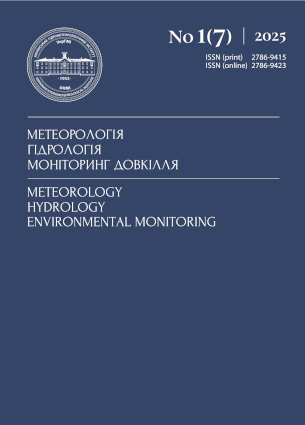RECOGNITION OF HYDROGEOLOGICAL DROUGHTS BY SPI AND SGI INDICES IN THE SOUTHERN BUG RIVER BASIN
Ukrainian Hydrometeorological Institute of State Emergency Service of Ukraine and National Academy of Sciences of Ukraine, Kyiv, Ukraine
https://orcid.org/0009-0002-9866-558X
Oleksii Shevchenko
Ukrainian Hydrometeorological Institute of State Emergency Service of Ukraine and National Academy of Sciences of Ukraine, Kyiv, Ukraine
https://orcid.org/0000-0002-5791-5354
Oleksandr Shchehlov
Ukrainian Hydrometeorological Institute of State Emergency Service of Ukraine and National Academy of Sciences of Ukraine, Kyiv, Ukraine
https://orcid.org/0000-0001-5702-6285
Abstract
References
1. Afanasiev, S., Letytska, O., Mudra, K., & Yaroshevych, O. (2022). River Basin Management Plan of the Southern Bug River Basin (Draft). Ministry of Environmental Protection and Natural Resources of Ukraine, State Water Resources Agency of Ukraine. [PDF document, in Ukrainian].
2. Bloomfield, J. P., & Marchant, B. P. (2013). Analysis of groundwater drought building on the standardised precipitation index approach. Hydrology and Earth System Sciences, 17(12), 4769–4787. https://doi.org/10.5194/hess-17-4769-2013
3. Geomaps of Ukraine. Zoning of Ukraine. Retrieved from https://geomap.land.kiev.ua
4. GIS State Water Cadaster of Ukraine. (2021). Boundaries of the Southern Bug River basin on the topographic map of Ukraine [Cartographic image]. Retrieved from https://geoportal.davr.gov.ua:81
5. McKee, T. B., Doesken, N. J., & Kleist, J. (1993). The standardized precipitation index: A tool for identifying droughts. Proceedings of the 8th Conference on Applied Climatology.
6. Mishra, A. K., & Singh, V. P. (2010). A review of drought concepts. Journal of Hydrology, 391(1–2), 202–216. https://doi.org/10.1016/j.jhydrol.2010.07.012
7. Shevchenko, O., Bublyas, V., & Oshurok, D. (2023). Combination of geophysical and hydrogeological data to explain contradictions between infiltration and atmospheric precipitation. Visnyk of Taras Shevchenko National University of Kyiv. Geology, 1(100), 111-123. https://doi.org/10.17721/1728-2713.100.13
8. Shevchenko O.L., Lobodzinskyi O.V., Nasedkin I.Yu., Chornomorets Yu.O., Shkliarenko V.V. 2024. Decomposition of river hydrographs taking into account data of hydrogeological observations. Geologičnij žurnal, 1 (386): 32–46. https://doi.org/10.30836/igs.1025-6814.2024.1.288190
9. Shevchenko, O., Skorbun, A., Osadchiy, V., & Charny, D. (2021). VARIABLE RHYTHMS IN GROUNDWATER REGIME AND THEIR RELATIONSHIP WITH CLIMATE FACTORS. Visnyk of Taras Shevchenko National University of Kyiv. Geology, 2(93), 71-82. https://doi.org/10.17721/1728-2713.93.08
10. Shevchenko, O. L., Skorbun, A. D., & Charnyi, D. V. (2021а). Subordination of fluctuations of groundwater levels in the Southern Bug river basin to climate change. Visnyk of Odesa National University. Geographical and Geological Sciences, 26(2(39)), 175-194. https://doi.org/10.18524/2303–9914.2021.2(39).246202
11. Shevchenko, O.L., Charny, D.V., Osadchiy, V.I., Il’chenko, A.O. (2021б). Groundwater runoff in the Pivdennyi Buh river basin in conditions of global warming. Geologìčnij žurnal, 3 (376), 03-16. https://doi.org/10.30836/igs.1025-6814.2021.3.237361
12. Van Lanen, H. A. J., Wanders, N., Tallaksen, L. M., & van Loon, A. F. (2013). Hydrological drought across the world: Impact of climate and physical catchment structure. Hydrology and Earth System Sciences, 17(4), 1715–1732. https://doi.org/10.5194/hess-17-1715-2013
13. Vicente-Serrano, S. M., Beguería, S., & López-Moreno, J. I. (2010). A multiscalar drought index sensitive to global warming: The standardized precipitation evapotranspiration index. Journal of Climate, 23(7), 1696–1718. https://doi.org/10.1175/2009JCLI2909.1
14. Ukrainian Hydrometeorological Center. Official website of the Ukrainian Hydrometeorological Center, State Emergency Service of Ukraine. https://meteo.gov.ua
15. Ukrainian Hydrometeorological Institute. Land & Water: Agro-hydrological model of river basins of Ukraine. Laboratory of River Systems Modeling. https://landwater.uhmi.org.ua/

